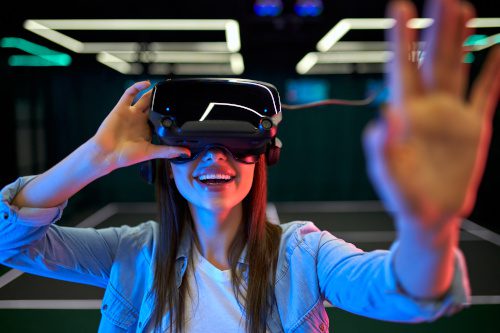Virtual Reality has been revolutionized by numerous technological innovations over the years, including hand tracking, eye tracking, realistic haptic feedback, mixed reality, full-body tracking, artificial intelligence, multiplayer VR, VR therapy, VR education, and VR storytelling. These advancements have made VR more immersive, natural, engaging, and interactive than ever before, providing numerous applications in fields like gaming, education, therapy, storytelling, and socializing. As developers continue to push the boundaries of VR through innovation and experimentation, it will be exciting to see where this technology will take us in the future.
1. Hand Tracking
Virtual Reality has been revolutionized with the introduction of hand tracking. It enables users to interact with the VR environment without the use of any handheld controllers. With the help of advanced sensors, the system can detect and track the subtle movements of the user’s hands and fingers.
2. Eye Tracking
Eye tracking is another innovation that enhances the user’s experience in Virtual Reality. It allows the system to detect the user’s eye movements and adjust the VR environment accordingly. This enables a more immersive and personalized experience for the user.
3. Realistic Haptic Feedback
Realistic haptic feedback has been a long-standing goal of Virtual Reality developers. The latest innovations allow the user to feel physical sensations in the VR world, such as the weight and texture of objects, giving the impression of a more natural experience.
4. Mixed Reality
Mixed Reality is a combination of Virtual Reality and Augmented Reality, where the virtual world and the real world are merged. This innovation enables users to interact with the virtual world while maintaining a connection with the real world.
5. Full-body Tracking
Full-body tracking allows the system to track the user’s entire body movements in real-time. This innovation provides a more natural and immersive experience for the user, as they can move and interact with objects in the VR environment as they would in the real world.
6. Artificial Intelligence
The incorporation of Artificial Intelligence (AI) in Virtual Reality has enabled developers to create more dynamic and intelligent VR experiences. AI can adjust the VR environment based on the user’s behavior and preferences, providing a more personalized and engaging experience.
7. Multiplayer VR
Multiplayer VR allows users to interact and collaborate with each other in a virtual environment. This innovation has opened up numerous possibilities for collaborative work, gaming, and socializing, enabling people from different parts of the world to connect and have real-time interactions.
8. VR Therapy
Virtual Reality Therapy is a cutting-edge technology that uses VR to simulate therapeutic scenarios and help people overcome phobias, anxiety, and other mental health issues. This innovation provides a safe and controlled environment for patients to undergo therapy and overcome their fears.
9. VR Education
VR Education has revolutionized the field of education, providing a more interactive and engaging learning experience for students. With VR, students can be transported to different parts of the world, experience historical events, and explore complex concepts in a more immersive and intuitive way.
10. VR Storytelling
VR Storytelling takes the traditional concept of storytelling to the next level by creating immersive and interactive narratives that enable users to experience stories like never before. This innovation has opened up new possibilities for content creators and artists, allowing them to create more engaging and memorable experiences for their audiences.
In conclusion, Virtual Reality has seen numerous innovations over the years, and these 10 exciting innovations are changing the way we experience VR. From realistic haptic feedback to AI integration, these innovations are expanding the possibilities for VR applications, making it an exciting field for developers, users, and researchers alike. With further innovation and experimentation, there is no telling where Virtual Reality will take us next.
